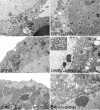Reconstitution of the Kaposi's sarcoma-associated herpesvirus nuclear egress complex and formation of nuclear membrane vesicles by coexpression of ORF67 and ORF69 gene products
- PMID: 22013050
- PMCID: PMC3255883
- DOI: 10.1128/JVI.05988-11
Reconstitution of the Kaposi's sarcoma-associated herpesvirus nuclear egress complex and formation of nuclear membrane vesicles by coexpression of ORF67 and ORF69 gene products
Abstract
The Kaposi's sarcoma-associated herpesvirus nuclear egress complex is composed of two proteins, ORF67 and ORF69. In this study, we have recapitulated the KSHV complex by coexpression of these two proteins in insect cells using expression from recombinant baculoviruses. The proteins form a complex at the nuclear membrane as judged by live-cell analysis of protein fusions tagged with green fluorescent protein (GFP) and mCherry. Ultrastructural analysis of infected cells showed that ORF67 expression results in reduplication of the nuclear membrane. When the two proteins are expressed together, numerous virion-size nuclear membrane-derived vesicles were evident at the nuclear margins.
Figures



Similar articles
-
Functional Identification and Characterization of the Nuclear Egress Complex of a Gammaherpesvirus.J Virol. 2019 Nov 26;93(24):e01422-19. doi: 10.1128/JVI.01422-19. Print 2019 Dec 15. J Virol. 2019. PMID: 31554685 Free PMC article.
-
Interactions of the Kaposi's Sarcoma-associated herpesvirus nuclear egress complex: ORF69 is a potent factor for remodeling cellular membranes.J Virol. 2013 Apr;87(7):3915-29. doi: 10.1128/JVI.03418-12. Epub 2013 Jan 30. J Virol. 2013. PMID: 23365436 Free PMC article.
-
Identification and characterization of the product encoded by ORF69 of Kaposi's sarcoma-associated herpesvirus.J Virol. 2008 May;82(9):4562-72. doi: 10.1128/JVI.02400-07. Epub 2008 Feb 27. J Virol. 2008. PMID: 18305046 Free PMC article.
-
The way out: what we know and do not know about herpesvirus nuclear egress.Cell Microbiol. 2013 Feb;15(2):170-8. doi: 10.1111/cmi.12044. Epub 2012 Nov 7. Cell Microbiol. 2013. PMID: 23057731 Review.
-
Pathological Features of Kaposi's Sarcoma-Associated Herpesvirus Infection.Adv Exp Med Biol. 2018;1045:357-376. doi: 10.1007/978-981-10-7230-7_16. Adv Exp Med Biol. 2018. PMID: 29896675 Review.
Cited by
-
Vesicular Nucleo-Cytoplasmic Transport-Herpesviruses as Pioneers in Cell Biology.Viruses. 2016 Sep 27;8(10):266. doi: 10.3390/v8100266. Viruses. 2016. PMID: 27690080 Free PMC article.
-
Mapping of sequences in Pseudorabies virus pUL34 that are required for formation and function of the nuclear egress complex.J Virol. 2013 Apr;87(8):4475-85. doi: 10.1128/JVI.00021-13. Epub 2013 Feb 6. J Virol. 2013. PMID: 23388710 Free PMC article.
-
Comprehensive Analysis of the Tegument Proteins Involved in Capsid Transport and Virion Morphogenesis of Alpha, Beta and Gamma Herpesviruses.Viruses. 2023 Oct 6;15(10):2058. doi: 10.3390/v15102058. Viruses. 2023. PMID: 37896835 Free PMC article. Review.
-
The Human Cytomegalovirus Transmembrane Protein pUL50 Induces Loss of VCP/p97 and Is Regulated by a Small Isoform of pUL50.J Virol. 2020 Jun 16;94(13):e00110-20. doi: 10.1128/JVI.00110-20. Print 2020 Jun 16. J Virol. 2020. PMID: 32321808 Free PMC article.
-
KSHV: pathways to tumorigenesis and persistent infection.Adv Virus Res. 2014;88:111-59. doi: 10.1016/B978-0-12-800098-4.00002-7. Adv Virus Res. 2014. PMID: 24373311 Free PMC article. Review.
References
Publication types
MeSH terms
Substances
Grants and funding
LinkOut - more resources
Full Text Sources

